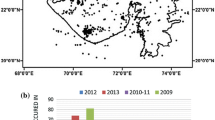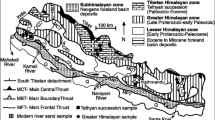Abstract
This paper presents results of a site-specific probabilistic seismic hazard analysis for northern part of the Qeshm Island, one the most seismic prone areas of Iran. Seismotectonic and seismicity properties of seismic sources in the study area were characterized and used for evaluation of various strong ground motion parameters implementing the classical Cornell’s PSHA approach. The results show that peak rock accelerations for 475-year return period are 0.4 and 0.27 g, respectively, for 84th and 50th percentiles while being about 0.37 and 0.61 g for 2475-year return period. These values are slightly smaller than those read from national seismic zonation maps which can be attributed to the considered conservatism for development of such design maps. In order to incorporate local site conditions, a series of dynamic site response analyses based on the equivalent linear approach were also employed. The results indicate that the presence of soft subsurface deposits at the site significantly alters the fundamental characteristics of the response spectra. The obtained median (50th percentile) peak ground accelerations for 975-year return period range between 0.49 and 0.54 g at different locations in the study site showing minor amplifications relative to their corresponding bedrock acceleration of 0.48 g. Finally, the obtained site-specific spectrum was compared with the standard spectrum mandated by the design codes. In this regard, the agreement was found to be reasonable at period ranges shorter than about 0.5 s, while the differences were more obvious at longer periods. This reveals the need for implementation of site-specific design spectrum to avoid underestimation or overestimation of seismic forces for designing critically important structures especially when softer deposits are encountered.




















Similar content being viewed by others
References
AASHTO LRFD Bridge Design Specifications (2012) American association of state highways and transportation officials. Washington DC
Ambraseys NN, Melville CP (1982) A history of Persian earthquakes. Cambridge University Press, London
Ansal AM, Iyisan R, Gullu H (2001) Microtremor measurements for the microzonation of dinar. Pure appl Geophys 158(12):2525–2541
Ansari A, Firuzi E, Etemadsaeed L (2015) Delineation of seismic sources in probabilistic seismic-hazard analysis using fuzzy cluster analysis and Monte Carlo simulations. Bull Seismol Soc Am 105(4):2174–2191
Bender B, Perkins DM (1987) SEISRISK III: A computer program for seismic hazard estimation, U.S. Geological Survey Bulletin 1772
Berberian M (1995) Master blind thrust faults hidden under the Zagros folds: active basement tectonics and surface morphotectonics. Tectonophysics 241:193–224
Berberian M, Papastamatiou D (1978) Khurgu (north Bandar Abbas, Iran) earthquake of March 21, 1977; a preliminary field report and a seismotectonic discussion. Bull Seismol Soc Am 68(2):411–428
Boore DM, Atkinson GM (2008) Ground-motion prediction equations for the average horizontal component of PGA, PGA, and 5%-Damped PSA at spectral periods between 0.01 and 10.0 s. Earthq Spectra 24(1):99–138
Campbell KW, Bozorgnia Y (2008) NGA ground motion model for the geometric mean horizontal component of PGA, PGV, PGD and 5% damped linear elastic response spectra for periods ranging from 0.01 to 10 s. Earthq Spectra 24(1):139–171
Chiou BSJ, Youngs RR (2008) An NGA model for the average horizontal component of peak ground motion and response spectra. Earthq Spectra 24(1):173–215
Cornell CA (1968) Engineering seismic risk analysis. Bull Seismol Soc Am 58(5):1583–1606
Desai S, Choudhury D (2014) Spatial variation of probabilistic seismic hazard for Mumbai and surrounding region. Nat Hazards 71:1873–1898
Eurocode 8 (2005) Design of structures for earthquake resistant-Part 2: bridges
Frankel A (1995) Map** seismic hazard in the central and eastern United States. Seismol Res Lett 66(4):8–21
Frankel A, Mueller C, Barnhard T, Rerkins D, Leyendecker EV, Dickman N (1996) National seismic-hazard maps, documentation, U.S. Geological Survey, Open-file Report 96-532
Gardner JK, Knopoff L (1974) Is the sequence of earthquakes in southern California, with aftershocks removed, Poissonian? Bull Seismol Soc Am 64(5):1363–1367
Griffiths SC, Cox BR, Rathje EM (2016) Challenges associated with site response analyses for soft soils subjected to high-intensity input ground motions. Soil Dyn Earthq Eng 85:1–10
Gullu H (2012) Prediction of peak ground acceleration by genetic expression programming and regression: a comparison using likelihood-based measure. Eng Geol 141–142:92–113
Gullu H (2013) On the prediction of shear wave velocity at local site of strong ground motion stations: an application using artificial intelligience. Bull Earthq Eng 11(4):969–997
Gullu H (2014a) A factorial experimental approach for effective dosage rate of stabilizer: an application for fine-grained soil treated with bottom ash. Soils Found 54(3):462–477
Gullu H (2014b) Function finding via genetic expression programming for strength and elastic properties of clay treated with bottom ash. Eng Appl Artif Intell 35:143–157
Gullu H (2015a) On the viscous behavior of cement mixtures with clay, sand, lime and bottom ash for jet grouting. Constr Build Mater 93:891–910
Gullu H (2015b) Unconfined compressive strength and freeze–thaw resistance of fine-grained soil stabilized with bottom ash, lime and superplasticizer. Road Mater Pavement Des 16(3):608–634
Gullu H (2016a) A novel approach to prediction of rheological characteristics of jet grout cement mixtures via genetic expression programming. Neural Comput Appl. doi:10.1007/s00521-016-2360-2
Gullu H (2016b) Comparison of rheological models for jet grout cement mixtures with various stabilizers. Constr Build Mater 127:220–236
Gullu H, Ercelebi E (2007) A neural network approach for attenuation relationships: an application using strong ground motion data from Turkey. Eng Geol 93(3–4):65–81
Gullu H, Fedakar HI (2016a) Response surface methodology for optimization of stabilizer dosage rates of marginal sand stabilized with Sludge Ash and fiber based on UCS performances. KSCE J Civ Eng. doi:10.1007/s12205-016-0724-x
Gullu H, Fedakar HI (2016b) Use of factorial experimental approach and effect size on the CBR testing results for the usable dosages of wastewater sludge ash with coarse-grained material. Eur J Environ Civil Eng. doi:10.1080/19648189.2016.1179678
Gullu H, Girisken S (2013) Performance of fine-grained soil treated with industrial wastewater sludge. Environ Earth Sci 70:777–788
Gullu H, Iyisan R (2016) A seismic hazard study through the comparison of ground motion prediction equations using the weighting factor of logic tree. J Earthq Eng 20(6):861–884
Gullu H, Jaf HS (2016) Full 3D nonlinear time history analysis of dynamic soil–structure interaction for a historical masonry arch bridge. Environ Earth Sci 75(21):1421
Gullu H, Pala M (2014) On the resonance effect by dynamic soil-structure interaction: a revelation study. Nat Hazards 72(2):827–847
Gullu H, Ansal A, Ozbay A (2008) Seismic hazard studies for Gaziantep city in South Anatolia of Turkey. Nat Hazards 44:19–50
Gullu H, Canakci H, Al Zangana IF (2017) Use of cement based grout with glass powder for deep mixing. Constr Build Mater 137:12–20
Haeri SM, Kavand A, Rahmani I, Torabi H (2012) Response of a group of piles to liquefaction-induced lateral spreading by large scale shake table testing. Soil Dyn Earthq Eng 38:25–45
Iranian Code of Practice for Seismic Resistant Design of Buildings (2015) Standard No. 2800 4th edition, Building and Housing Research Center, Publication No. S-253
Jackson JA, Fitch T (1981) Basement faulting and the focal depths of the larger earthquakes in the Zagros Mountains (Iran). Geophys J R AstronSoc 64(3):561–586
Kavand A, Haeri SM, Raisianzadeh J, Padash H, Ghalandaradeh A (2012) Performance evaluation of stone columns as mitigation measure against lateral spreading in pile groups using shake table tests. In: Proceedings of the international conference on ground improvement and ground control, Wollongong, Australia
Kavand A, Haeri SM, Asefzadeh A, Rahmani I, Ghalandarzadeh A, Bakhshi A (2014) Study of the behavior of pile groups during lateral spreading in medium dense sands by large scale shake table test. Int J Civil Eng 12(3-B):186–203
Khan Z, El-Emam M, Irfan M, Abdalla J (2013) Probabilistic seismic hazard analysis and spectral accelerations for United Arab Emirates. Nat Hazards 67:569–589
Kijko A, Sellevoll MA (1989) Estimation of earthquake hazard parameters from incomplete data files, Part I: utilization of extreme and complete catalogues with different threshold magnitudes. Bull Seismol Soc Am 79:645–654
Kramer SL (1996) Geotechnical earthquake engineering. Prentice-Hall, New Jersey, p 653
McQuarrie N (2004) Crustal scale geometry of the Zagros fold–thrust belt. Iran J Struct Geol 26(3):519–535
Mezcua J, Rueda J, Blanco MG (2011) A new probabilistic hazard study of Spain. Nat Hazards 59:1087–1108
Mirzaei N (1997) Seismic zoning of Iran. Dissertation, Institute of Geophysics. State Seismological Bureau, Bei**g, People’s Republic of China
Mirzaei N, Gao M, Chen YT (1998) Seismic source regionalization for seismic zoning of Iran: major seismotectonic provinces. J Earthq 7:465–495
Moinfar A, Mahdavian A, Maleki E (1994) Historical and instrumental earthquake data collection of Iran. Mahab Ghods Consultant Engineers Company, Iran (in Persian)
Nissen E, Ghorashi M, Jackson J, Parsons B, Talebian M (2007) The 2005 Qeshm Island earthquake (Iran)-a link between reverse faulting and surface folding in the Zagros Simply Folded Belt? Geophys J Int 171:326–338
Nissen E, Yamini-Fard F, Tatar M, Gholamzadeh A, Bergman E, Elliott JR, Jackson JA, Parsons B (2010) The vertical separation of mainshock rupture and microseismicity at Qeshm island in the Zagros fold-and-thrust belt, Iran. Earth Pedantry Sci Lett 296:181–194
Nowroozi AA (1985) Empirical relations between magnitudes and fault parameters for earthquakes in Iran. Bull Seismol Soc Am 75:1327–1338
Pacific Earthquake Engineering Research Center, PEER (2011) Users manual for the peer ground motions database web application. The Peer Center, University of California, Berkeley (CA). http://peer.berkeley.edu/peer_ground_motion_database/site
Pehlivan M, Rathje EM, Gilbert RB (2016) Factors influencing soil surface seismic hazard curves. Soil Dyn Earthq Eng 83:180–190
Phuong NH (2001) Probabilistic seismic hazard assessment along the southern coast of vietnam. Nat Hazards 24:53–74
Savage WU, Alt JN, Mohajer-Ashjai A (1977) Microearthquake investigations of the 1972 Qir, Iran, earthquake zone and adjacent areas. Abstr Programs Geol Soc Am 9:496
Seed HB, Idriss IM (1970) Soil moduli and dam** factors for dynamic response analyses. Report EERC 70-10, Earthquake Engineering Research Center, University of California, Berkeley
Selcuk L, Selcuk AZ, Beyaz T (2010) Probabilistic hazard assessment for Lake Van basin, Turkey. Nat Hazards 54:949–965
Shoja-Taheri J, Naserieh S, Hadi G (2010) A test of the applicability of NGA models to the strong ground-motion data in the Iranian Plateau. J Earthq Eng 14:278–292
Sil A, Sitharam TG, Kolathayar S (2013) Probabilistic seismic hazard analysis of Tripura and Mizoram states. Nat Hazards 68:1089–1108
Tinti S, Mulargia F (1985) Completeness analysis of a seismic catalog. Ann Geophys 3:407–414
Von Dollen FJ, Alt JN, Tocher D, Nowroozi A (1977) Seismological and geological investigations near Bandar Abbas, Iran. Abstr Programs Geol Soc Am 9:521
Vucetic M, Dobry R (1991) Effect of soil plasticity on cyclic response. J Geotech Eng ASCE 117(1):89–107
Wells DL, Coppersmith KJ (1994) Updated empirical relationships among magnitude, rupture length, rupture area and surface displacement. Bull Seismol Soc Am 84:4–43
Acknowledgements
The present research would not be completed without the valuable data of geotechnical site investigations provided by Sahel Consulting Engineers Company. The authors would like to express their great thanks to the managers and decision-makers of the company for their valuable help in this regard.
Author information
Authors and Affiliations
Corresponding author
Rights and permissions
About this article
Cite this article
Kavand, A., Alielahi, H. Site-specific probabilistic seismic hazard analysis for northern part of the Qeshm Island, Iran. Nat Hazards 88, 919–946 (2017). https://doi.org/10.1007/s11069-017-2898-z
Received:
Accepted:
Published:
Issue Date:
DOI: https://doi.org/10.1007/s11069-017-2898-z




